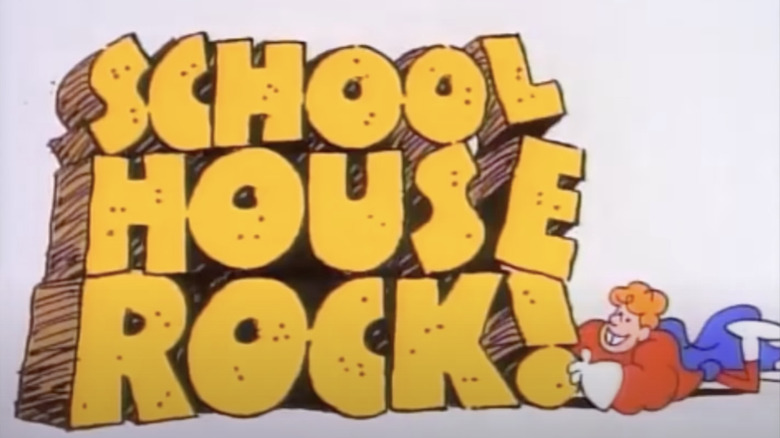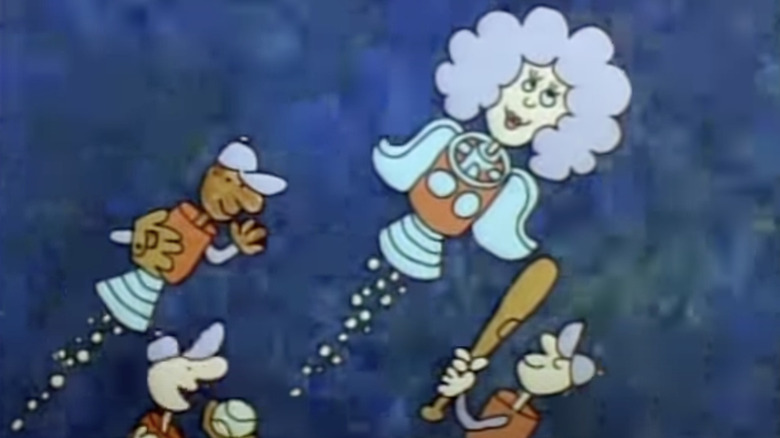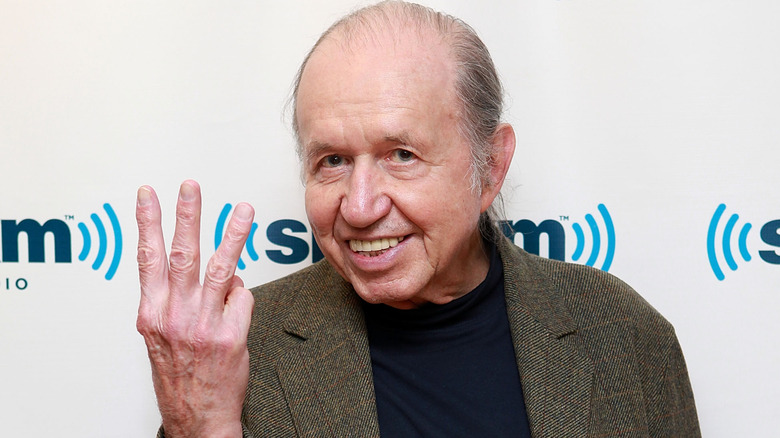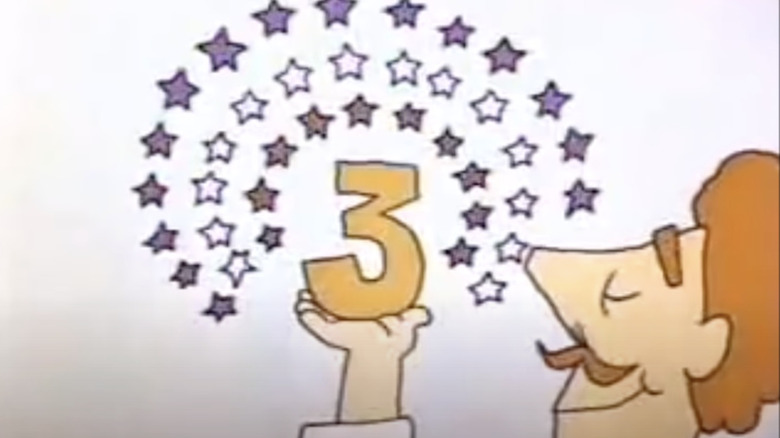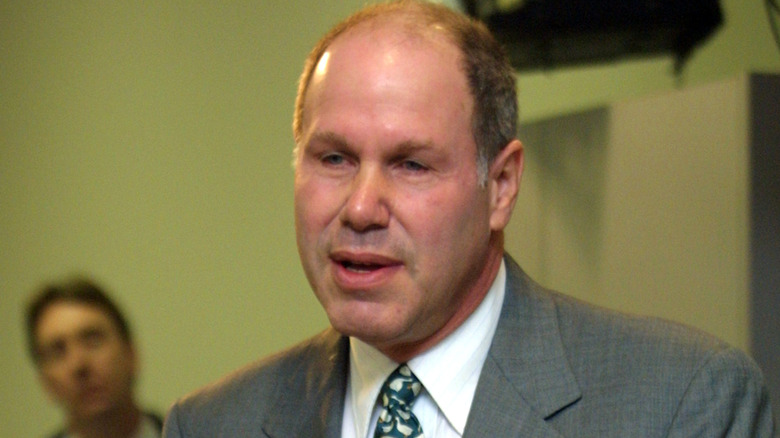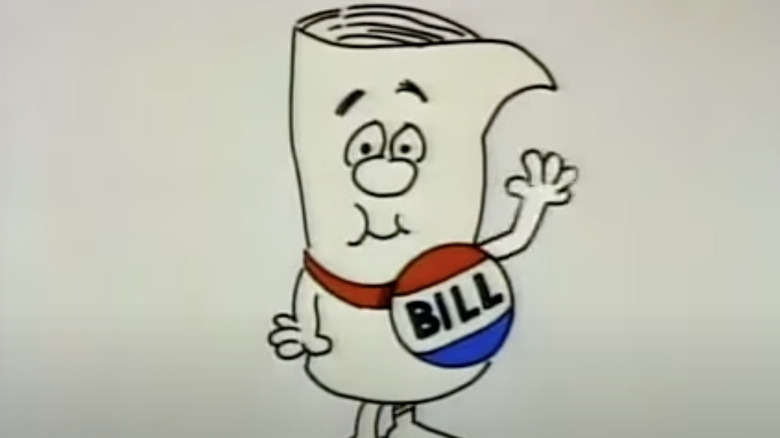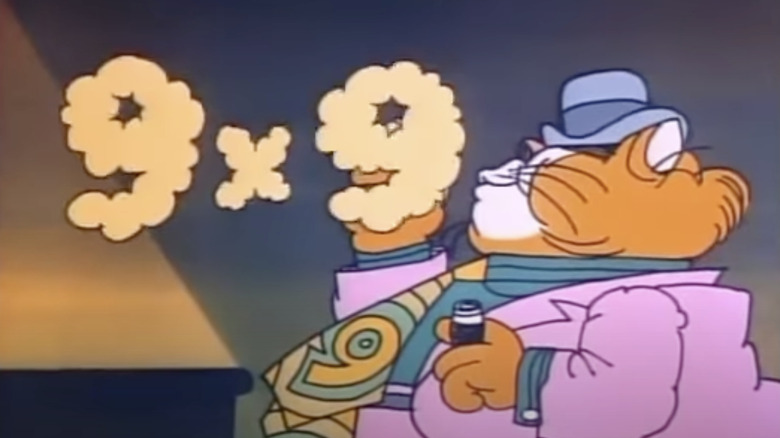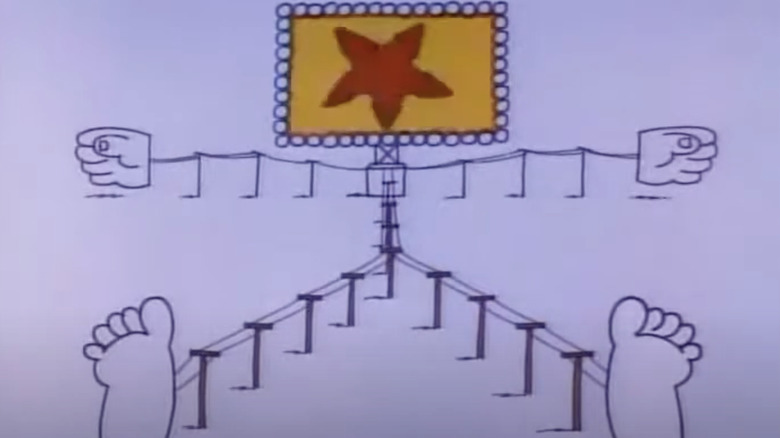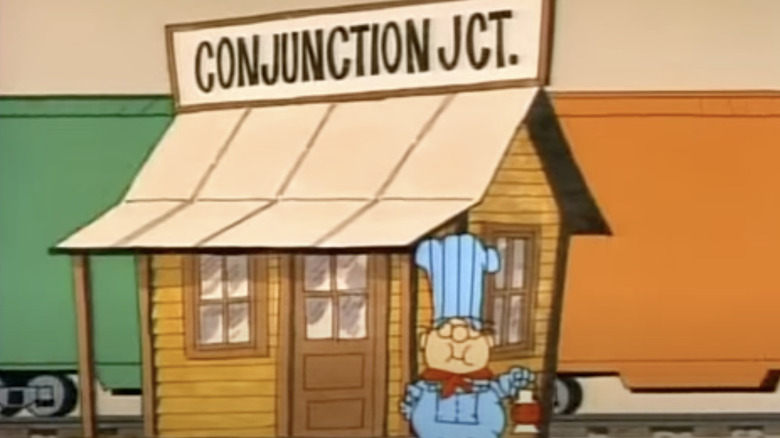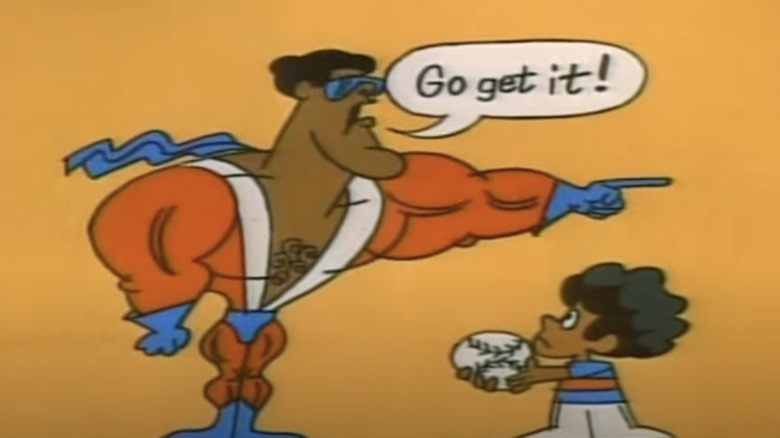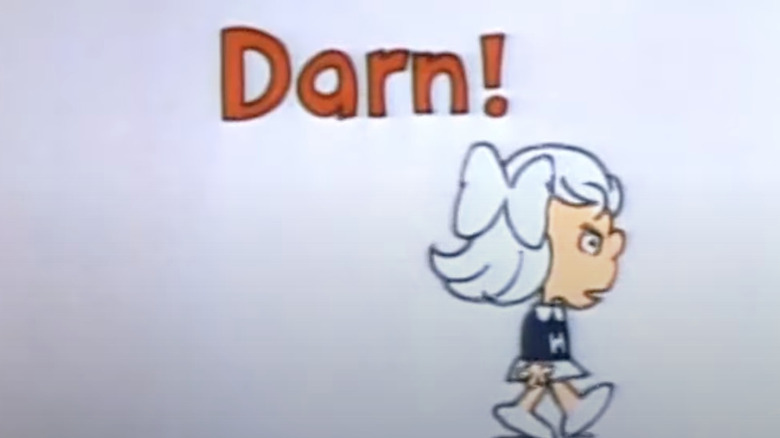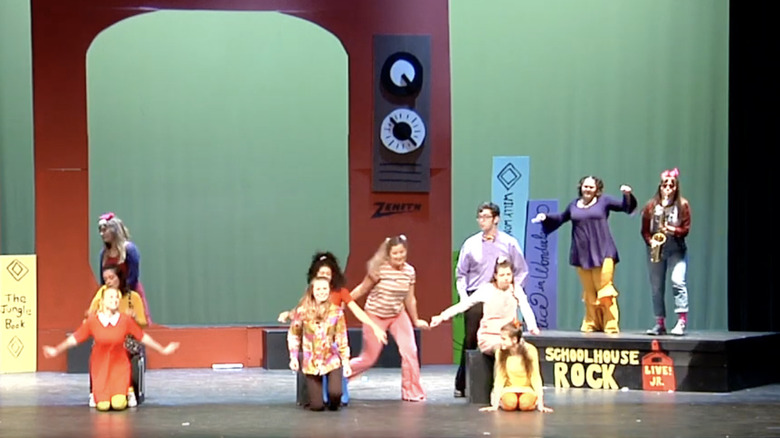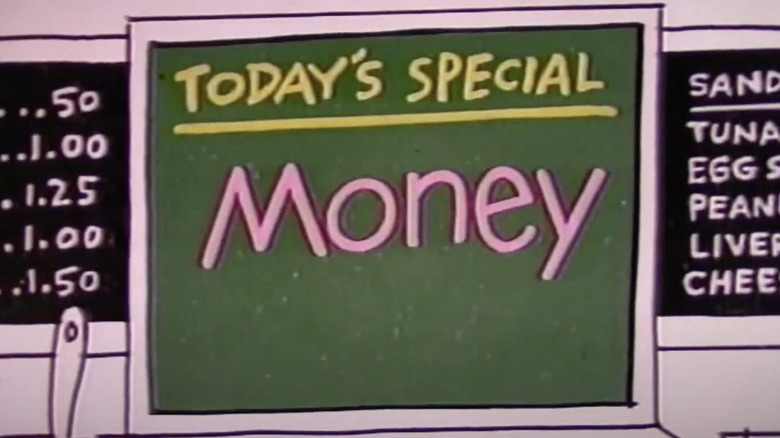The Untold Truth Of Schoolhouse Rock!
The Saturday morning block of network television was supposed to be a respite for kids, all entertainment and free of anything educational — but then along came "Schoolhouse Rock!" to teach a great many things disguised as short cartoons, accompanied with extremely catchy rock and pop tunes.
Beginning in 1973, and airing regularly among ABC's lineup of cartoons and kid-oriented entertainment on Saturday mornings for more than a decade, "Schoolhouse Rock!" delivered lessons on math concepts, English grammar, civics, history, economics, and science in a palatable and deeply entertaining way; as animated music videos. Of the dozens of episodes played and replayed over the years, many are fondly remembered cultural relics for Generation X, particularly "I'm Just a Bill," "Conjunction Junction," "Interplanet Janet," "Unpack Your Adjectives," "No More Kings," and "Elbow Room."
A hallmark of educational TV, "Schoolhouse Rock" has delighted kids and former kids for over 50 years in various iterations. Its format was so effective that some episodes have even directly contributed to the education of adults in such lofty professions as medicine and politics. Here's a look into the history and impact of "Schoolhouse Rock!"
An advertising agency created Schoolhouse Rock!
In the early 1970s, David McCall, president of the McCaffrey and McCall advertising agency, took his family on a vacation to a Wyoming dude ranch. He observed that his son, Davey, seemed to have an encyclopedic knowledge of the lyrics of the Rolling Stones and any other number of major rock bands. To the elder McCall, that skill conflicted with his son's inability to memorize his multiplication tables at school. That experience planted an idea in McCall's head: Kids might remember fundamental educational concepts and basic knowledge if they were presented as rock and pop song lyrics.
Initially, McCall focused on making an album of educational songs, specifically and particularly songs about math. In need of original music, McCall asked one of the advertising agency's jingle writers to write a song that was essentially multiplication tables set to music. He didn't like what he heard, because it sounded too much like a cloying commercial jingle.
How Schoolhouse Rock! found magic with its first number
Unhappy with what a staff jingle writer created for their first attempt, David McCall sought an outside songwriter. His colleague, art director George Newall, who was also a musician, knew a jazz bassist named Ben Tucker, who in turn recommended his collaborator Bob Dorough, a pianist who also worked with Miles Davis and Hoagy Carmichael. "He said, 'My partner, Bob Dorough, can do anything. He can put music to anything,'" Dorough told NPR's "Fresh Air." He met with ad executive David McCall, who explained that they wanted a song about multiplication tables, as his son's difficulty with the subject (and love of rock music) inspired the project.
Dorough got the job because he was the only composer whose audition song took the "rock" part of "Schoolhouse Rock!" seriously. "I learned later that he had invited other Broadway songwriters to do this task, and they came up with a more simple doggerel type of songwriting — writing down, as it were, to children." It took Dorough three weeks to write "Three is a Magic Number," and to get the lyrics and themes correct, he reached math, magic, and even occult books.
Schoolhouse Rock! was vetted by educators
From the very beginning, "Schoolhouse Rock!" organizers took the educational element of the project seriously, and they wanted to make sure that they not only delivered accurate information, but that they delivered it in a manner deemed suitable and effective. David McCall, advertising agency partner and one of the developers of the "Schoolhouse Rock!" concept, served on the board of directors of Bank Street College of Education, a New York educational institution. To see if "Schoolhouse Rock!" was viable, he asked the school to play the demo recording of "Three is a Magic Number" to kids in schools situated inside New York City and in the surrounding suburbs. Bank Street College representatives used the song to both reinforce knowledge of multiplication tables as well as to introduce the idea.
With the certification of a legitimate educational organization secured, "Schoolhouse Rock!" production continued. A Bank Street College representative would continue to consult on the series for years, with an educational expert there taking about a week to sign off on the lyrics of each short before recording could occur.
It was supposed to be a record and a book, not a cartoon series
Bolstered by Bob Dorough's "Three is a Magic Number," the McCaffrey and McCall team set out to get their educational songs project to the world. "The idea of television wasn't remotely in their heads," Dorough told NPR's "Fresh Air." In fact, David McCall envisioned the project as an album packaged with a book. And yet, despite the pedigree and a good presentation, McCall and McCaffrey couldn't get any traction with publishers with the initial book and record deal, pitched under the name "Multiplication Rock."
The approach changed completely when someone at the advertising agency noticed that one of its clients was ABC. So, the art department drew up a series of storyboards (the planned animation, presented as sequential images) synchronized with Dorough's recording of "Three is a Magic Number." They then presented it to Michael Eisner, future president of The Walt Disney Company (itself a future owner of ABC), at the time installed as vice president for Children's Programming at ABC.
Eisner brought along accomplished animated director Chuck Jones to the meeting. The creative force behind Warner Bros' Roadrunner and Wile E. Coyote cartoons, and director of "How the Grinch Stole Christmas," Jones was presently in charge of a Saturday morning anthology called "Curiosity Shop." Jones enjoyed the presentation and recommended that Eisner buy "Multiplication Rock" for use on his series. The first-ever "Schoolhouse Rock!" segment aired on "Curiosity Job," nearly two years before it became a standalone interstitial on ABC's Saturday morning lineup.
The best-known Schoolhouse Rock! tunes were recorded back to back
Two of the best-known songs to ever air as part of "Schoolhouse Rock!" demonstrate the breadth and ambition of the entire series. "Conjunction Junction" (1973) is a funky folk number that uses train imagery to explain how "if," "and," and "but" connect words, phrases, and clauses, while "I'm Just a Bill" is a soul-tinged story song that patiently explains how a bill becomes a law in the U.S. system of government. They're very different songs, and yet they were recorded with the same personnel.
Handling lead vocals on "Conjunction Junction" was Jack Sheldon, an accomplished jazz singer. He was also a trumpet player, and he contributed those skills to "Conjunction Junction," alongside other prolific Los Angeles session musicians Leroy Vinegar (bass), Stuart Scharf (guitar), Teddy Edwards (saxophone), Nick Ceroli (drums), and Dave Frishberg (piano). That's the same credits as those for "I'm Just a Bill." Released two years after "Conjunction Junction," it was recorded on the same day during the same session as "Conjunction Junction," and Jack Sheldon sang lead on that one, too.
ABC almost banned an installment of Schoolhouse Rock!
"Schoolhouse Rock!" was a series geared toward an audience of elementary school-age viewers, hence its instruction of basic concepts of grammar, math, science, and history, as well as its Saturday morning time slot, in between kids' cartoons. All this held the makers of "Schoolhouse Rock!" to a certain standard as far as content, and while the vast majority of episodes were squeaky-clean and all-ages-appropriate in almost every way, producers had difficulty getting one particular episode onto the air due to network concerns.
The 1973 episode "Naughty Number Nine" taught kids all the unique quirks of the number nine, and it prominently featured a cat (also named Naughty Number Nine) hanging out in a pool hall, puffing on a cigar throughout, forming math problems with the resultant smoke. For depicting pervasive smoking, ABC's Broadcast Standards and Practices nearly wouldn't allow "Naughty Number Nine" to air in its original form. However, "Schoolhouse Rock!" producers persuaded the censors against ordering edits, arguing that the smoking helped characterize Naughty Number Nine as a villain.
Another "Schoolhouse Rock!" cartoon was temporarily and preemptively banned. Completed in the mid-1970s, "Three-Ring Government" explains the three branches of the U.S. government (executive, judicial, and legislative) in the form of a kid dreaming that each segment is part of a trilogy of circus acts. ABC didn't air the piece until 1979, and co-creator George Newall explained why to Noblemania, saying, "[It was] because of their fear that the FCC and Congress would resent being compared to a circus and threaten their broadcast license renewal."
Trainers loved Schoolhouse Rock
David McCall led the creation of "Schoolhouse Rock!" based on the idea that catchy pop-rock could be used to teach educational concepts, and cause the imparted information to take root in the minds of its audience of young children. As a testament to the effectiveness of the method, and "Schoolhouse Rock!" songwriters' unique execution of the concept, several of the episodes were used to educate adults.
"I'm Just a Bill" is a 1975 "Schoolhouse Rock!" episode that provides a step-by-step lesson in how a proposed bill becomes a Congressionally-approved, codified law. Beginning in the mid-1970s, and for many years after, the offices of members of Congress (as well as lobbyist groups) would call "Schoolhouse Rock!" production facilities to request tapes of "I'm Just a Bill" to share with their staffers so they'd understand their jobs better.
"Schoolhouse Rock!" also helped educate many doctors and other medical professionals. The University of Michigan Medical School, as well as the Columbia College of Physicians and Surgeons, worked with "Schoolhouse Rock!" producers to use the 1979 anatomy-based clip "Telegraph Line" to explain to first-year medical school students how the nervous system functions.
It wasn't always Schoolhouse worthy
"Schoolhouse Rock!" is an evocative title, and the cartoons that carried its name in the 1970s and 1980s made it a household name and a recognized brand in educational television. And yet, its title was neither the creators' original idea nor the first choice for a name. Early in the show's development and prior to its debut on the ABC Saturday morning schedule, producers operated the project under a title that strongly connoted both an instructional element and a musical bent: "Scholastic Rock."
However, there's already a well and long-established company by that name, which produces materials and uses an approach considerably similar to that of the TV animation project: Scholastic, a publisher of educational and entertainment books for children, operator of school book fairs, and printers of an educational magazine, had been operational in some form since the 1920s. When lawyers representing Scholastic heard about "Scholastic Rock!," they ordered a name change. Looking to avoid a lawsuit, the TV contingent decided on "Schoolhouse Rock!" instead. The music publishing side of the endeavor, however, was allowed to retain the name Scholastic Rock.
There's a lost Schoolhouse Rock! song
Not every song prepared for inclusion in the "Schoolhouse Rock!" series made it to the air. Some didn't even get much past the songwriting stage and into animation. And with good reason. The 1974 "Grammar Rock" segment "Verb: That's What's Happening" was a replacement for another song about verbs, the part of speech that connotes action.
Veteran "Schoolhouse Rock!" composer and lyricist Bob Dorough came up with a song that had a lot of action in it, because that would translate well into the visual medium of "Schoolhouse Rock!" cartoons. Producers had originally intended to animate a cartoon for a song by "I'm Just a Bill," which writer Dave Frishberg called "A World Without Verbs." However, the very nature of the song made it tough to animate, or even result in a boring final product. The concept involved a world where not much happens, simply because there aren't any verbs to make activity occur. In the end, "A World Without Verbs" never received a full production.
Darn! That's the end?
Part of the "Grammar Rock" collection of "Schoolhouse Rock!" shorts, "Interjections!," educated viewers on the proper usage of outbursts. The song itself names "Hey!" and "Ouch!" and "Well!" among others, and takes things full circle when it ends with an interjection. The last bit of the song is a spoken sentence: The voice of a disappointed little girl cries out, "Darn! That's the end?" Heard often on "Schoolhouse Rock!" cartoons, that line was voiced by Lauren Yohe, who, at the time that "Interjections!" was recorded in 1974, was six years old. She happens to also be the daughter of "Schoolhouse Rock!" lead designer, Tom Yohe.
That was not the only time that a "Schoolhouse Rock!" employee utilized the voice talents of their children to round out a cartoon designed for children. In the 1977 "History Rocks" segment "Fireworks," the voice that recites "That all men are created equal" (from the Declaration of Independence) is producer Radford Stone's ten-year-old daughter, Charlotte. The boy who adds, "And that they are endowed by their Creator," is Stone's son, 12-year-old Ian. In "I'm Just a Bill," musician Jack Sheldon portrays Bill, the anthropomorphic bill, who explains the law-making process to a boy, portrayed by Sheldon's son, John.
How Schoolhouse Rock! lived on
In the early 1990s, nostalgia-fueled renewed interest in "Schoolhouse Rock!" led to a new appreciation and exploration of the educational cartoon collection in other, very visible forms of mainstream media. "Schoolhouse Rock Live" debuted at the Cabaret Voltaire in Chicago in August 1993, and enjoyed an eight-month run to sellout crowds. The creators built a self-aware narrative around the disparate "Schoolhouse Rock!" shorts, with a plot concerning a nervous rookie teacher. In the show, the teacher gains the confidence he needs when characters from the educational TV show emerge from his mind — and his TV — and perform the songs that made them famous, like "Conjunction Junction" and "I'm Just a Bill." A shorter version designed for school theater departments is frequently performed around the U.S.
In 1996, Atlantic Records subsidiary Lava Records collected some of the era's major alternative rock bands and rappers to contribute to "Schoolhouse Rock! Rocks." It's a "Schoolhouse Rock!" tribute album, with acts covering '70s-era favorites. Pavement recorded "No More Kings," Blind Melon took on "Three is a Magic Number," and Skee-Lo did "The Tale of Mr. Morton."
It almost faded into oblivion
After a 12-year run of multiple weekly airings on ABC's Saturday morning lineup, "Schoolhouse Rock!" ended its original broadcast run in 1985. (An executive in ABC's children's programming division wanted to end the series in favor of "ABC Funfit," an exercise and fitness show starring Olympic gymnast Mary Lou Retton.) And then, unlike most TV series that run for longer than a decade, it seemingly didn't leave enough of a cultural footprint to merit preservation.
Many of the constituent elements of the "Schoolhouse Rock!" cartoons disappeared or were destroyed. Producers allowed the animation cels to be discarded, while they lost track of the arrangements for the music. The master audio tapes, recorded in 24-track format, went missing and were discovered in a Connecticut barn.
Nostalgia is what would save "Schoolhouse Rock!" from complete obscurity. In early 1990, organizers of a symposium on education at Dartmouth College invited the producers and writers of the show to attend. Around 900 students attended, and they were all acutely familiar with "Schoolhouse Rock!" songs. That followed a petitioning drive at college campuses, beginning at the University of Connecticut, urging ABC to revive "Schoolhouse Rock!" in some way. Indeed, in 1994, the series made a comeback to ABC with a new slate of episodes teaching financial literacy, called "Money Rock."
